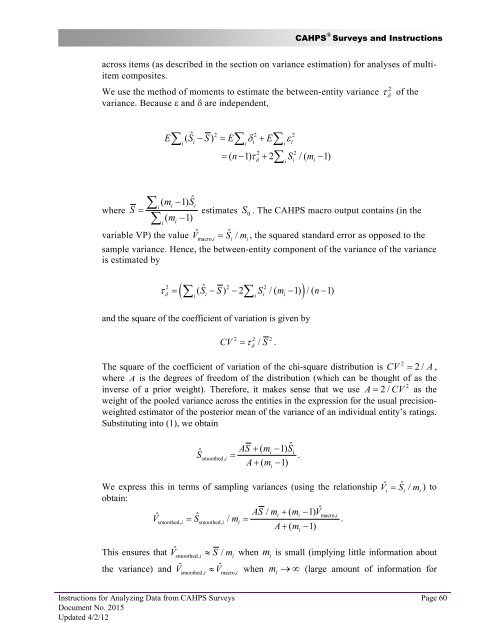Instructions for Analyzing Data from CAHPS Surveys
Instructions for Analyzing Data from CAHPS Surveys
Instructions for Analyzing Data from CAHPS Surveys
You also want an ePaper? Increase the reach of your titles
YUMPU automatically turns print PDFs into web optimized ePapers that Google loves.
<strong>CAHPS</strong> ® <strong>Surveys</strong> and <strong>Instructions</strong><br />
across items (as described in the section on variance estimation) <strong>for</strong> analyses of multiitem<br />
composites.<br />
2<br />
We use the method of moments to estimate the between-entity variance τδ<br />
of the<br />
variance. Because ε and δ are independent,<br />
∑ ∑ ∑<br />
∑<br />
E ( Sˆ<br />
− S)<br />
= E δ + E<br />
2 2 2<br />
i i i i i i<br />
ε<br />
2 2<br />
( n 1) τδ<br />
2 Si<br />
/ ( mi<br />
1)<br />
i<br />
= − + −<br />
where<br />
S<br />
=<br />
∑i<br />
∑<br />
( m −1)<br />
Sˆ<br />
i<br />
i<br />
( m −1)<br />
i<br />
i<br />
estimates S<br />
0<br />
. The <strong>CAHPS</strong> macro output contains (in the<br />
variable VP) the value Vˆ ˆ<br />
macro, i<br />
= Si / mi, the squared standard error as opposed to the<br />
sample variance. Hence, the between-entity component of the variance of the variance<br />
is estimated by<br />
(<br />
ˆ<br />
∑i<br />
i ∑i<br />
i i )<br />
τ = ( S −S) −2 S / ( m −1) / ( n−1)<br />
2 2 2<br />
δ<br />
and the square of the coefficient of variation is given by<br />
CV<br />
2 2 2<br />
τ δ<br />
/ S<br />
= .<br />
2<br />
The square of the coefficient of variation of the chi-square distribution is CV = 2/ A ,<br />
where A is the degrees of freedom of the distribution (which can be thought of as the<br />
2<br />
inverse of a prior weight). There<strong>for</strong>e, it makes sense that we use A = 2/ CV as the<br />
weight of the pooled variance across the entities in the expression <strong>for</strong> the usual precisionweighted<br />
estimator of the posterior mean of the variance of an individual entity’s ratings.<br />
Substituting into (1), we obtain<br />
Sˆ<br />
smoothed, i<br />
=<br />
AS + ( m 1) ˆ<br />
i<br />
− Si<br />
A+ ( m −1)<br />
i<br />
.<br />
We express this in terms of sampling variances (using the relationship Vˆ ˆ<br />
i<br />
= Si / m ) to<br />
i<br />
obtain:<br />
ˆ<br />
ˆ ˆ<br />
AS / mi + ( mi −1)<br />
Vmacro,<br />
i<br />
Vsmoothed,<br />
i<br />
= Ssmoothed,<br />
i<br />
/ mi<br />
=<br />
.<br />
A+ ( m −1)<br />
This ensures that Vˆ smoothed, i<br />
≈ S / mi<br />
when m<br />
i<br />
is small (implying little in<strong>for</strong>mation about<br />
the variance) and Vˆ<br />
ˆ<br />
smoothed, i<br />
≈ V macro, i<br />
when mi<br />
→∞ (large amount of in<strong>for</strong>mation <strong>for</strong><br />
i<br />
<strong>Instructions</strong> <strong>for</strong> <strong>Analyzing</strong> <strong>Data</strong> <strong>from</strong> <strong>CAHPS</strong> <strong>Surveys</strong><br />
Document No. 2015<br />
Updated 4/2/12<br />
Page 60



